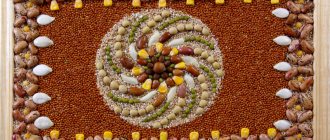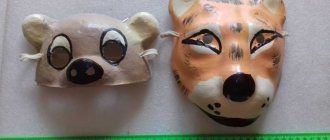Weaving a square basket from newspaper tubes: master class, photo
Weaving from newspaper tubes is a very unusual, but very popular handicraft that almost anyone can do. In addition, this handicraft is not expensive, because it does not require purchasing materials. Any product woven in this way is made from the most ordinary newspapers, rolled into a thin tube and fixed with varnish.
What is required for this job:
- Shape - any square-shaped object that allows the product to have a given silhouette: vase, box, jar, drawer, toy, and so on. Choose an item that suits you in size.
- Newspapers – any sheets of newspaper, double sheets preferably.
- Clothespins - regular or stationery, are needed for fixation while weaving a basket.
- Scissors - for work
- Glue – dry or PVA for fixing and twisting tubes.
- Decorative materials - to add design to the finished product.
- A long wooden skewer is necessary for curling a sheet of newspaper.
- Cardboard – necessary to create the bottom of the product
How to weave a basket:
- Flatten the newspaper sheet
- Take a skewer and place it towards the edge of the newspaper sheet.
- Roll up the newspaper sheet and begin rolling, rolling the sheet tightly.
- Newsprint should be coated with glue so that it curls and sticks in place.
- If you used PVA, let the twisted tubes dry a little.
- Cut out the base for the basket, a square: large or small.
- Glue the tubes to the base and secure with clothespins, let dry completely.
- Remove the clothespins and glue a second square (exactly the same), press and secure. Let dry.
- Place the form on top of the bottom and begin weaving, tying each vertical tube with a horizontal one.
- The weaving looks very solid, because you shouldn’t weave several tubes. Each time you glue several tubes into one long strip, which you work with.
- Press the ends of the protruding tubes onto the mold with clothespins
- When weaving, you need to use patterns to create a pattern and carefully weave the edges of the tubes inside.
Detailed master class in photos:
Square basket
Weaving a basket - the basis
If your choice falls on weaving a basket, the main thing is to decide on the shape. To master the method of weaving from newspaper tubes, it is better to start by weaving a square or rectangular basket, and use cardboard of the required size to make the bottom of the product.
To the bottom cut out of cardboard we glue tubes along the entire perimeter with PVA glue at the same distance, which allows us to subsequently make a braid. We glue the same cardboard on top, as if placing the tubes between the double bottom.
For strong fixation, we clamp everything with clothespins or special stationery clips and let the glue dry.
There is another way to make the bottom, in which wide strips of several tubes are glued together in advance, and then laid out in a certain order: vertical strips are placed over one or under the horizontal ones.
After this, single tubes, which subsequently become racks for the walls, braid the vertical glued strips of the bottom. The protruding edges of the bottom of the product are trimmed evenly.
Weaving a rectangular basket from newspaper tubes: patterns, diagrams, description
You need to weave a rectangular basket from newspaper tubes according to the same principle as a square one. If you wish, you can also weave a lid, which should be only 1 cm in diameter larger than the product itself.
Step-by-step weaving in photos:
Materials for work: Twisting tubes with a skewer
Gluing tubes
Thick tubes are vertical, thin tubes are horizontal
Gluing the cardboard base, fixing with clothespins
Gluing the second cardboard, inner bottom
Fixing with clothespins until dry Establishing the shape and braiding it
You can weave using only vertical tubes or weave horizontal ones You adjust the height of the product yourself Fix the product with clothespins at the top to make it easy to work
Completing the weaving
Wrapping the tubes
The final stage of work
Rolling the tubes inward
Cutting tubes that are too long: the ends can be left or glued
We design the handle
The simplest pen
In the photo it looks like this:
To make it, you need to take a bunch of 3-4 tubes, form a bend in the handle and attach the workpiece to the basket. Next, carefully wrap the entire handle with a moistened tube, periodically lubricating it with glue so that the winding fits tightly. For this job it is better to use polymer glue than PVA. It dries quickly and fixes, while the paper does not have time to get wet.
Instead of a bundle of tubes, you can take a thick wire (cable) and wrap it around several tubes at once. The process in the photo looks like this:
Handle design using chintz weaving
It looks like this:
To work, take moistened tubes and immediately increase their length. Mark their locations on the basket. Use an awl to make holes and insert tubes into them. Glue the ends while they dry, secure them with clothespins.
Give the tubes the desired bend. To make them better hold their shape, you can insert 1-0.9 mm thick wire into them in advance. Using a working tube, we braid these 3 main tubes with simple calico weaving.
Simple twisted handle
In the photo she looks like this:
It is also quite easy to do for a beginner. For small pens you need to take a bundle of 5-7 tubes, you can insert a wire into one of them. Next, they need to be laid, intertwined with rope and gradually twisted.
We present to you a detailed MK from Lada Ligai, in which each step is accompanied by a photo.
If you still don’t understand how to properly twist and round such a handle, there is only one way out - urgently watch a detailed video from a craftswoman.
Sturdy twisted basket handle
It is better to make it using a thick cable or willow rod.
For ease of perception, we suggest you watch 3 stages of working on the handle.
Part 1: You will learn how to correctly insert a willow rod into the wall of a basket:
Part 2: How to wrap it with paper vine:
Part 3: Features of fastening the handle with a beautiful connecting lock.
Openwork handle
Do you want to surprise everyone with the unusual and elegant look of your basket? Then you urgently need to master openwork knitting handles.
For this method, each paper tube of the handle base must be reinforced with wire. You will learn the specifics of the work from our recommended video from Irina Chirkova.
A similar pen looks like this:
It's very easy to do, step by step:
8 tube braid
The photo shows what a handle looks like, woven with an ordinary volumetric braid of 8 pipes.
If the thickness of the handle is not enough for you, then you can insert a cable, television wire, thick wire or a bunch of paper tubes inside. The thicker version will look like this:
The process of weaving such a braid is covered in detail in a video from Olga Ryzhkova.
Below are step-by-step photographs of attaching the handle to the basket and neatly decorating the lock:
Wooden handle
You can also use an ordinary thick branch as a handle. Take a walk to the nearest park and get the material absolutely free. The found branch must be sawed off to the desired shape, cleaned by removing the bark, and sanded for smoothness. If desired, you can paint the wood with stain and cover it with acrylic varnish.
Look how beautiful and unusual such handles on baskets look.
Weaving an Easter basket from newspaper tubes: patterns, diagrams, description
You don’t have to buy a beautiful Easter basket; you can weave it yourself from scrap material – newspaper tubes. These baskets can be filled with Easter treats and given to your loved ones. Depending on how many treats you want to put inside or how much skill you have, there are several designs and ways to make such a product.
IMPORTANT: Weaving is similar to the previous lessons, however, to create such a basket you should not use cardboard for the bottom, but a round shape (a dish or a deep plate), which you will tie.
In order to create a small basket with a handle, you will need about 90-100 tubes, which should be twisted in advance. Let the tubes dry and only then get to work:
- Weave together 8 tubes with a double cross
- Start tying in a circle to make the base.
- Place the base form on top of the knitted small round bottom.
- Tie it, lengthening the tubes and creating patterns (for this you should use weaving patterns).
- To ensure that the product is neat and even, the tubes should be secured vertically, pinching them to the edge of the mold.
- The handle for the basket is knitted separately in the same way as weaving a braid from several tubes at once (see photo).
Step-by-step weaving with photos:
Creating the bottom
Tying the base: deep dish
Fixing with clothespins
After tying, remove the form Tying the edges, rolling the tubes Weaving the handle: preparation
Weaving into the edges of the warp
Fixing handles with clothespins
The handle weaves at both ends
Tying the ends and tying them with tubes for a neat look
LiveInternetLiveInternet
Quote from Marrietta
Read in full In your quotation book or community!
Do you like to weave from newspapers? Then come and visit) Today I want to show you wonderful braids performed by Natalia Korochkova. The author wove baskets specifically for storing onions, and I think that they would also be perfect for needlework - for knitters. In such a basket you can store balls and knit with threads directly from the basket. Very neat and beautiful work) Thanks to the author for the master class and inspiration)
The author wove the bottom for the braids according to the master class from Sovenok for these baskets:
So, let's watch a master class on weaving baskets for food or handicrafts. But, first, I want to share a useful link with you) If you have a car and, like a real Russian, you love driving fast, then you definitely need to purchase a new generation radar detector, which is designed specifically for Russian users. Cobra radar detectors, which have already gained popularity, have customizable options; they not only warn about the signals of existing radars, but also focus on the location of stationary radar systems. Read more on pulsevision.ru.
Below is the author's text. She braided a five-liter bucket. This was the first mistake - I needed a smaller shape, the basket turned out to be too big for me. I wove a round bottom, lately I have been weaving only the way the Owl taught me stranamasterov.ru/node/595525
I glue two 3x3 “crosses” from the tubes with a glue gun. I flatten the tubes at the gluing points.
Using the same gun I glue the “crosses” together. I use a square to keep the angles equal.
I prepare glue, scissors and moistened tubes.
As I work, I will turn the weave to the wrong side, so in order not to confuse you, I will mark the front side of the weave with a blue letter “L”, and the wrong side with a pink letter “I”. Front side. Without gluing the tip, I begin to wrap the cross with one tube.
Front side. I came to the beginning of the first row of winding.
Wrong side - I trim the beginning of the working tube. I glue the working tube to its beginning, but NOT to the cross! I do this so that later I can freely move apart the tubes of the cross.
This is what gluing looks like on the wrong side. I'm starting the second row of winding.
This is what the front side looks like.
The tube is almost finished. I cut off the unevenly colored end of the tube and join it to the new tube.
I wind 3 rows.
Wrong side. 3 full rows wound. I leave the tip sticking out. I'll glue it on later.
Front side. I substitute (do not glue) a new tube for the second layer of winding.
Front side. I finish the first row of the second layer of winding.
On the wrong side, I cut the tip again and glue the working tube to its beginning, but NOT to the cross.
Front side. I have already wound 2 layers of 3 rows. I spread the crosspiece tubes, helping with a thick knitting needle.
I substitute the second working tube for weaving with a rope.
I weave with a rope, pushing apart the remaining tubes of the cross.
The first row of rope is completed.
Three rows of rope are completed. I think everything else is clear.
The glass salad bowl used to weave these baskets. Diameter 22 cm. Height 9 cm.
I added one more to the seven racks. The second mistake is that you need to add additional. racks to half of all racks, then it will be more convenient to get the bow. I wanted to ensure that when you take out the onion, the rest roll out onto the “balcony”.
I wove a rope out of four tubes, while simultaneously raising (or lowering) the racks for the walls.
Then she wove a rope from two tubes, bent the double posts outward, weaving a “balcony.” In the second row, she began to separate the double posts one at a time. First, both outer ones, after 4 rows again the outermost ones, so we gradually spread out all the double posts, thereby expanding the “balcony”. When I was weaving the second house, I decided to open all the double posts in the first row at once, I liked it better this way, it made for a more convenient “balcony” design.
Here you can clearly see how the racks were spread.
I wove only 18 rows. I started to weave a rope from 4 tubes (start not on the balcony), I braided the stands on the “balcony” into a rope. The ends of the racks after trimming are well hidden under a rope of 4 tubes.
I wove a row, moved to the second according to Richard’s MK stranamasterov.ru/node/390898?c=favorite, only we have a string not of three, but of four, so at the 4th stage with the right tube we circle the marked riser and the next TWO and start for the FOURTH riser . And we begin to weave the reverse rope. I finished the second row using the same MK, only I have a reverse rope, so the last turns are not laid on top as in stages 13-18, but are pulled under the first ones, as if we were braiding a braid; from the drawing you can understand where to drag it. I reached the “balcony” and stopped for now.
I placed new racks and wove the rope further on these racks.
I wove a little more chintz and decided to make an inner lip so that the lid would rest on it. I did it like here stranamasterov.ru/node/717067, only at first I bent the racks not inward, but outward, and when lifting them up I carried them under two.
Made a bend stranamasterov.ru/node/201794?c=favorite
I took out the bucket and... was disappointed - my hand somehow fits into the hole, but with the onion it gets completely stuck. I gave up on this case and wove the second one for now - working on the mistakes. Then I took scissors and “expanded” it at the top, making an arch. I disguised the cuts with catfish (I glued it with hot glue, and the handle too). It's a completely different matter!
The cover was woven on the ball, as Ilfat showed stranamasterov.ru/node/620504. Fits perfectly on the inner side
Now I’ll tell you a little about the second house. I braided a three-liter jar, doubled half of the racks, in the second row I separated all the pairs one at a time, and tried to tilt the “balcony” as far forward and down as possible.
I wove 12 shortened rows (you can see how in the photo) so that I didn’t have to cut it out again. Then, in the same way, I framed the racks and 9 more rows with a rope in a circle.
In the corners where there were no tubes glued
I made a fold around the window: behind the next one outwards
under next up
pulled it inside and cut it (smeared a little with PVA glue)
I inserted one more into the racks and made the same bend as on the window. After I pulled the ends of the racks inward, I wove a side on them, on which the lid rests.
How to weave a handle. Master class from Martik
As I already wrote, this braid is very convenient for the handles of all kinds of baskets, since it is voluminous and very dense. To weave it, we take 8 tubes. We distribute them in pairs in this way.
For convenience, I placed the ends of the tubes on PVA glue and secured them with a clothespin
We begin to weave. We weave (alternately) ALWAYS only with the outermost RIGHT and LEFT tubes. Take the rightmost tube (highlighted in red) and bring it UNDER 5 tubes and bring it out BETWEEN the left paired tubes
Then we lay it on top of the second left pair. PSHere and further - we lay ALL the tubes strictly PARALLEL to the adjacent tube
We are done with the right tube (red). This was the first step. Now we do the same with the left tube (blue). We insert the LEFTmost tube UNDER 5 tubes. We output BETWEEN the right paired tubes
We lay it ON TWO tubes. Step two is complete.
The whole braid consists of just two steps. Very easy to do. Repeat the first step again. Far right UNDER 5 tubes
AND ON TOP 2 tubes
Far left UNDER 5 tubes
and 2 tubes
Shall we repeat? ) Far right UNDER 5 tr. and ON 2 tr. Far left UNDER 5 tr. and ON 2 tr. All!
Source stranamasterov.ru/node/754927?c=favorite
Marrietta's inspiration
Weaving an oval basket from newspaper tubes: photo, description
An oval basket woven from ordinary newspaper tubes can serve as an excellent piece of furniture and a dish for some food products, for example, sweets, fruit or bread. Making such a product is not difficult, and upon completion of the work you can paint it with any color and even varnish it. This coating will give the basket strength and moisture resistance.
In its principle, weaving an oval basket is similar to other products (square and rectangular, ordinary baskets), however, in this case, special attention should be paid to creating the bottom. You, of course, can use a cardboard base, or you can weave it by hand, which is much more beautiful.
How to weave an oval basket:
In order to make the base, you need to intertwine several tubes together
You can fasten the tubes together by tying them together
After the base is made, start weaving in the usual way.
When you have tied the required diameter of the bottom, wrap and lift the tubes up
Secure the tubes with clothespins and continue weaving
Weaving baskets of different shapes
Baskets of various shapes are used for different needs. For example, a rectangular high basket is useful for storing linen, a square or round one is suitable for storing sewing accessories, and an oval design would be appropriate for decorating a room for the holidays. Detailed master classes on making each form are presented below.
Square model
Square basket
This type of product is perfect as a tabletop bread bin. All you need to do is place a fabric insert inside and a beautiful bread box to serve to your guests – it’s ready. The work will be based on the use of a special device to help weave the base of the product faster.
Weaving a square basket
Detailed master class
To make such an auxiliary device, just take a sheet of cardboard, bend it in half lengthwise and use a hole punch to make holes for the tubes 2 cm from the fold. You also need to prepare a large number of paper or newspaper bundles.
To make the basket more like a straw one, make the twists flat.
- We insert the sticks for the base into the holes of the cardboard so that most of them are closer to the work.
- We begin to braid the bottom: take a long tube and insert it next to the cardboard, then we work using the rope weaving technique. When we reach the desired perimeter of the square, we finish the bottom.
- To form and lift the walls, we insert new splinters around the perimeter of the square: bend the twist in half and thread it into the hole, grabbing the nearest tube. We fix the fastening points with tape and clothespins.
- We begin to braid the walls until we get the height. For ease of work, we put the structure on a square box.
Can be used as a bread box
When the work is finished, you can attach a handle to it or weave an additional cover. Such a basket will not only serve as a bread bin, but will also be a good option for a packaging box.
Oval basket
The oval type product is considered the second most popular after the round basket. This form is more spacious and can be used as a box, packaging box, or simply for storing handy items. The product itself is decorated:
- flowers;
- ribbons;
- threads;
- various textiles.
All the same materials are needed for work:
- newspaper tubes made from strips measuring 11x28 cm;
- knitting needle;
- glue;
- stain;
- varnish;
- decor
The first stage is traditionally considered to be the manufacture of a cross: in a rectangular design it looks and is made differently. Since weaving the rope into 2 tubes is used, it is necessary to thread double twists across it.
One of the most popular forms
Weaving a “chicken” basket from newspaper tubes: photo, description
The “chicken” basket is very impressive and is perfect for making surprises for loved ones during the Easter holidays. It can be filled with dyes and Easter cakes and given as a gift to family and friends. Of course, such a product is much more difficult to weave than a regular basket, however, using video lessons and master classes, you can create a basket of incredible beauty.
Prepare a sufficient number of tubes in advance. Do the weaving according to the usual method: first create the bottom, and then put the form down and tie it. Choose a shape that is not very large, since the chicken should not be huge - this product is miniature and decorative.
Beginning of work
Ready product:
Chicken baskets
Weaving a round basket from newspaper tubes: photo, description
A round basket made of newspaper tubes is a beautiful and practical product that can be used as a box to store personal items: jewelry, money, cosmetics, threads and much more. Depending on your preferences, you can make a basket of any diameter, with a lid or handle, and decorate it with different accessories.
Step-by-step creation in photos, master class:
Creating the bottom
Weave until the required diameter is reached
The bottom can also be made from a cardboard base
Tie the basket as usual
How to make a rectangular newspaper basket
Base for a rectangular newspaper basket
- Using PVA, we glue four straws together lengthwise. To do this, first we fasten two and clamp them with clothespins, then we fasten the pairs together.
- Separately, we prepare paired glued tubes.
- We place parts of two and four straws in the following order: in a vertical position - three pairs, in a horizontal position - four bundles of four straws, on top - vertically two pairs. We place the latter in such a way that they are located in the spaces between the lower pairs.
- We use a single straw to weave paired bundles in a checkerboard pattern. If necessary, add elements from four tubes, folding all the parts more tightly.
- Thus, we bring the bottom to the desired size.
Weaving the walls of a rectangular basket from newspapers
- We glue paired tubes at the corners of the future basket and the sides of the bottom in increments of 5-7 cm.
- We take a couple of tubes and glue them in the corners. We interweave the vertical posts in a cross pattern and glue them on the other side.
- We glue the second pair and weave it in a mirror order.
- We braid the racks using this method to the desired height.
- At the end, we cut one straw, bend the second and thread it into the resulting recess.
- We glue the ends of the short free edges hidden under the previous row and fix them with clothespins for 10-15 minutes.
Lid and handles for a rectangular newspaper basket
- We make small indentations in the side surface with a stationery knife.
- We insert the tubes from all sides.
- We braid the edges of the lid, bending one part after another.
- At the end we hide the free ends under the lid.
- At the two upper edges of the basket we insert two pairs of tubes.
- We stretch them to the middle, bend them around and intertwine them together.
- Lubricate the edges with PVA and fasten with clothespins.
Depending on the size, such a basket can be used both for storing gloves or other accessories, and for linen.
Weaving baskets from newspapers: photos of models
You can get inspired by beautiful products by looking at photos of ready-made and woven baskets. It’s hard to believe, but each of them is connected precisely from unnecessary and old newspapers.
Miniature baskets
Oval basket
Bread box Square baskets
Marine style baskets











